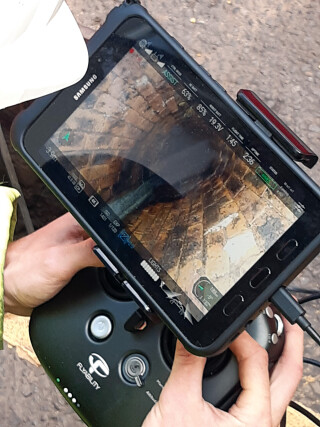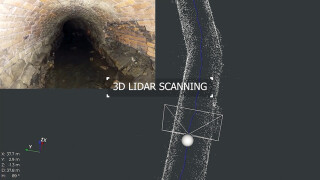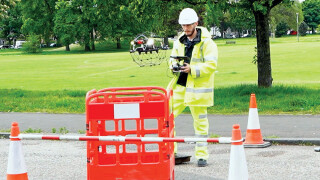Drones have become a valuable tool in the construction industry, providing the ability to inspect structures that are difficult or dangerous to access directly.
Most of these applications involve accessing structures at height but, in a radical departure, Scottish Water has been using flying drones underground, as a means of surveying its network of sewers.
A combination of drones and laser technology adapted for use in the waste water industry is being deployed to survey sewers for potential problems by flying the drones inside them, often to parts of the network that traditional surveying methods cannot reach.
Using the new techniques will enable the water company to assess the sewers’ condition more accurately and make key decisions about investment in maintenance or rehabilitation work to improve them.

It is hoped that this will make the 33,000-mile sewer network more resilient, improve Scottish Water’s service to customers, and reduce the risk of leaks, collapses and environmental pollution.
The new technique is more efficient, too, replacing teams of up to 15 workers with just two operatives. Scottish Water also says that the use of drones with light detection and ranging (LiDAR) scanning and measurement techniques will also reduce carbon emissions from sewer surveys by as much as 80%.
LiDAR scanning is said to be more accurate than traditional methods. The data gathered by the drones should enable Scottish Water to cut the cost of repairs & maintenance and improve its ability to target investment. And there is, of course, the added benefit of avoiding the need to put workers’ safety at risk.
Many of the sewers, some dating back to the Victorian era, have previously been difficult to access but much more of the network is now reachable following the collaboration between Scottish Water, its alliance partner Caledonia Water Alliance (CWA), civil engineering trenchless specialist Environmental Techniques and drone manufacturer Good Friday Robotics.
The adapted technology was used together for the first time in July on a large brick sewer under Bath Street in Glasgow city centre. Scottish Water now plans to roll the method out for use at other locations in Glasgow, Edinburgh, Aberdeen and some rural areas.

Sewer inspections, which seek to identify issues such as cracks, holes, partial collapses, infiltration, and root ingress, are needed to enable Scottish Water to make decisions on investment and the earlier any repairs and maintenance work is carried out, the lower the costs are to the company.

The drones and LiDAR provide substantially better video quality, defect confirmation and location accuracy than traditional techniques.
LiDAR is a laser scanning tool that measures distance, while the associated software creates an accurate computerised 3D point field output that can be viewed on-screen. The drone carries the LiDAR and camera onboard as it flies inside the sewer.
A worker pilots the drone as it flies through the sewer and uses video for visual inspection and LiDAR for measurement. The outputs are then manually reviewed by operators to spot and code the defects.
The drones were adapted specifically for sewers and are made of carbon fibre to reduce their weight and thus extend battery life.
“As we are working efficiently using this technology we are making significant carbon savings by not using any plant and people resources unnecessarily,” says Iain Jones, risk and life-cycle planning manager at Scottish Water. “Those who would have been doing these surveys in a traditional ‘worker-entry’ way will be redeployed to other tasks where we can still use their skills.
“This is the first time we’ve used drones adapted for sewers and LiDAR together for sewer surveys and we are really excited about it,” he adds.
Jones continues: “We want to improve the accuracy of our surveys and, for safety reasons, we want to reduce the number of workers needed to carry out survey work inside sewers. The drone does both and they will also help us in our aim to reach net zero carbon emissions by 2040.

“Factors such as depth, flows and debris can significantly slow down a worker entry survey in a way that does not affect the drones.
“Because of the reduction in the number of workers involved, a large number of site vans and vehicle deliveries are not required and so carbon emissions are reduced.”
Shauna Herron, a director at Environmental Techniques, says: “We’re delighted to be working with Scottish Water, CWA and Good Friday Robotics on the adaptation of these cutting-edge technologies to help maintain and improve the network of sewers under the streets of our cities and towns. The fact that it will also improve workers’ safety and reduce carbon emissions is really important.”
The project has already attracted the attention of the Pipeline Industries Guild, which in July awarded the team with its Utility Pipeline Technology Award. The team was also shortlisted for the Product Innovation of the Year award at the British Construction Industry Awards in October.
Got a story? Email news@theconstructionindex.co.uk


